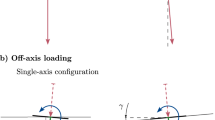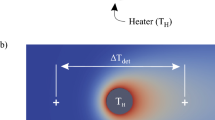Abstract
Experimental measurements are used to validate a numerical model of a dynamic resonant wall shear stress sensor. The numerical model consists of an unsteady two-dimensional boundary-layer model for the flow and a simple mechanical model for the sensor itself. The sensor’s sensitivity to wall shear stress is experimentally determined in a flat-plate boundary layer, and the results agree closely with those from the numerical simulations. Using the validated model, it is determined that the energy lost in each sensor oscillation due to the interaction between the sensor and fluid increases with increasing mean wall shear stress.























Similar content being viewed by others
References
Allen JM (1976) Systematic study of error sources in supersonic skin-friction balance measurements. Technical report, Langley Research Center, Hampton
Allen JM (1977) Experimental study of error sources in skin-friction balance measurements. J Fluid Eng 99:197–205
Amit KS (2005) A dynamic resonant wall shear stress sensor for fluids. Master’s thesis, University Of Wyoming
Armstrong WD, Singhal A, Naughton JW (2004) A dynamic resonant wall shear stress sensor. AIAA Paper 2004-2608
Barlian AA, Park SJ, Mukundan V, Pruitt BL (2007) Design and characterization of microfabricated piezoresistive floating element-based shear stress sensors. Sens Actuators: A Phy 134:77–87
Cebeci T (1978) An unsteady laminar boundary layer with separation and reattachment. AIAA J 16:1305–1306
Fourguette D, Modarress D, Wilson D, Koochesfahahani M (2003) An optical mems-based shear stress sensor for high reynolds number applications. American Institute of Aeronautics and Astronautics
Fukagata K, Kasagi N (2004) Suboptimal control for drag reduction via suppression of near-wall reynolds shear stress. Int J Heat Fluid Flow 25:341–350
Goldberg HD, Breuer KS, Schmidt MA (1994) A silicon wafer-bonding technology for microfabricated shear-stress sensors with backside contacts. In: Technical digest, solid-state sensor and actuator workshop, pp 111–115
Hammond EP, Bewley TR, Moin P (1998) Observed mechanisms for turbulence attenuation and enhancement in opposition-controlled wall-bounded flows. Phys Fluids 10:2421–2423
Haritonidis JH (1989) The measurement of wall shear stress. In: Gad-el-Hak M (eds) Advances in fluid mechanics, Springer, Berlin, pp 229–261
Horowitz S, Chen T, Chandrasekaran V, Tedjojuwono K, Nishida T, Cattafesta L, Sheplak M (2004) A micromachined geometric moiré interferometric floating element shear stress sensor. AIAA 2004-1042
Jiang F, Lee GB, Tai Y (2000) A flexible micromachine-based shear stress sensor array and its application to separation-point detection. Sens Actuators 79(2000):194–203
Johansson G (2005) Personal communication
Krai LD, Fasel HF (1991) Numerical investigation of three-dimensional active control of boundary layer transition. AIAA J 29:1407–1417
Lee C, Kim J (2002) Control of the viscous sublayer for drag reduction. Phys Fluids 4:2523–2529
Lee KH, Cortelezzi L, Kim J (2001) Application of reduced-order controller to turbulent flows for drag reduction. Phys Fluids 13:1321–1330
Lew J, Huang A, Ho CM (2004) Surface shear stress reduction with mems sensors/actuator in turbulent boundary layers. AIAA 2004-424
Li Y, Chandrasekharan V, Bertolucci B, Nishida T, Cattafesta L, Sheplak M (2008) A mems shear stress sensor for turbulence measurements. AIAA 2008-269
Naughton JW, Brown JL (1996) Surface interferometric skin-friction measurement technique. AIAA Paper 96-2183
Naughton JW, Sheplak M (2002) Modern developments in shear-stress measurement. Prog Aerosp Sci 38:515–570
Naughton JW, Viken S, Greenblatt D (2004) Wall shear stress measurements on the NASA hump model for CFD validation. In: Paper 2004-2607, 24th AIAA Aerodynamic Measurement Technology and Ground Testing Conference, Portland
Naughton JW, Viken S, Greenblatt D (2006) Skin friction measurements on the NASA hump model. AIAA J 44:1255–1265
Naughton JW, Liu T (2007) Photogrammetry in oil film interferometry. AIAA J 45(7):1620–1629
Ng K, Shajii J, Schmidt MA (1992) A liquid shear-stress sensor using wafer-bonding technology. J MEMS 1:89–94
Padmanabhan A (1997) Silicon micromachined sensors and sensor arrays for shear stress measurements in aerodynamic flows. PhD thesis, Mechanical Engineering Department, Massachusetts Institute of Technology, Cambridge
Plesniak WM, Peterson DS (2004) Wall shear stress measurements for conventional applications and biomedical flows. In: AIAA 2004-2301
Podin B, Lumley J (1998) Reconstructing the flow in the wall region from wall sensors. Phys Fluids 10:1182–1190
Rathnasingham R, Breuer KS (1997) System identification and control of a turbulent boundary layer. Phys Fluids 9:1867–1869
Rumsey CL, Gatski TB (2003) Summary of easm turbulence models in cfl3d with validation test cases. Tech. rep., Langley Research Center, Hampton
Rumsey CL, Spalart PR (2008) Turbulence model behavior in low reynolds number regions of aerodynamic flowfields. In: AIAA 2008-4403
Schetz JA (2004) Direct measurement of skin friction in complex flows using movable wall elements. In: AIAA 2004-2112
Schiffer M, Obermeier E (2006) Aeromems surface fence for wall shear stress measurements in turbulent flows. In: AIAA 2006-645
Schmidt MA, Howe RT, Senturia SD, Haritonidis JH (1988) Design and calibration of a microfabricated floating-element shear-stress sensor. Trans Electron Devices ED-35:750–757
Sheplak M, Padmanabhan A, Schmidt MA, Breuer KS (2001) Dynamic calibration of a shear stress sensor using stokes-layer excitation. AIAA J 39:819–823
Sheplak M, Chandrasekaran V, Cain A, Nishida T, Cattafesta L (2002) Characterization of a micromachined thermal shear stress sensor. AIAA J 40(6):1099–1104
Sheplak M, Cattafesta L, Nishida T (2004) Mems shear stress sensors: Promise and progress. In: AIAA 2004-2606
Tseng FG, Lin CJ (2003) Polymer mems-based fabry-perot shear stress sensor. IEEE SENSORS J 3(6):812–817
Tyler C, Fonov SD (2004) Comparison of computationally predicted and experimentally measured skin friction. In: AIAA 2004-2304
Winter KG (1977) An outline of the techniques available for the measurement of skin friction in turbulent boundary layers. Progr Aerosp Sci 18:1–57
Zhang X, Naughton JW, Armstrong WD, Lindberg W (2004) Numerical model of a dynamic resonant shear stress sensor. In: AIAA Paper 2004-2395
Zhang X, Naughton JW, Lindberg W (2008) Working principle simulations of a dynamic resonant wall shear stress sensor concept. Sens J 8:2707–2721
Zhang X, Naughton JW, Lindberg W (2009) 2-d and 3-d numerical modelling of a dynamic resonant shear stress sensor. Comput Fluids 38:340–346
Acknowledgments
The authors would like to acknowledge the invaluable contributions to the development of this sensor by the second author William D. Armstrong who passed away in September 2006. He will be missed. This work supported in part by NSF under grant CTS-0500502 monitored by Michael Plesniak.
Author information
Authors and Affiliations
Corresponding author
Rights and permissions
About this article
Cite this article
Zhang, X., Armstrong, W.D., Lindberg, W.R. et al. Experimental validation of a dynamic resonant wall shear stress sensor. Exp Fluids 53, 1107–1121 (2012). https://doi.org/10.1007/s00348-012-1347-8
Received:
Revised:
Accepted:
Published:
Issue Date:
DOI: https://doi.org/10.1007/s00348-012-1347-8




